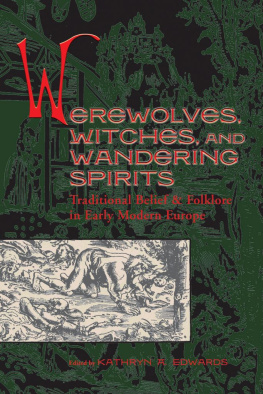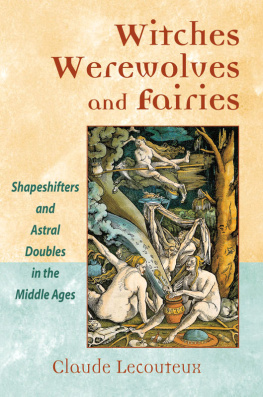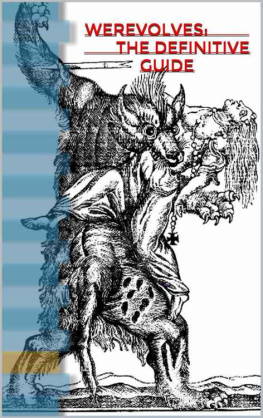Werewolves
Werewolves
A Field Guide to Shapeshifters, Lycanthropes, and Man-Beasts
By Dr. Bob Curran

Copyright 2009 by Bob Curran
All rights reserved under the Pan-American and International Copyright Conventions. This book may not be reproduced, in whole or in part, in any form or by any means electronic or mechanical, including photocopying, recording, or by any information storage and retrieval system now known or hereafter invented, without written permission from the publisher, The Career Press.
WEREWOLVES
EDITED AND TYPESET BY GINA TALUCCI
Cover design by Lucia Rossman/DigiDog Design
Printed in the U.S.A. by Courier
To order this title, please call toll-free 1-800-CAREER-1 (NJ and Canada: 201-848-0310) to order using VISA or MasterCard, or for further information on books from Career Press.

The Career Press, Inc., 3 Tice Road, PO Box 687,
Franklin Lakes, NJ 07417
www.careerpress.com
www.newpagebooks.com
Library of Congress Cataloging-in-Publication Data
Curran, Bob.
Werewolves : a field guide to shapeshifters, lycanthropes and man-beasts / by Bob Curran.
p. cm.
Includes index.
ISBN 978-1-60163-089-6
1. Werewolves. I. Title.
GR830.W4C87 2009
398.24'54--dc22
2009025581
Contents
Introduction
A Walk on the Wild Side
Chapter 1
The Shadow of the Wolf
Chapter 2
Man Into Beast
Chapter 3
Old Irish Wolves and Other Wonders
Chapter 4
The French Connection
Chapter 5
Barking Mad
Conclusion
Fangs Aint What They Used to Be
Introduction:
A Walk on the Wild Side
Somewhere among the shadows which throng the deepest recesses of the human mind, a ferocious beast is crouching. This is something extremely ancient and primala relic of mankinds original history, a fragment of his initial, bestial nature. Although the eons have left a veneer of civilization and culture on us, the beast still waits deep within every one of us, ready to emerge at any time if the conditions are right, to create mayhem, and even death, all around it.
That at least is the theory, both psychological and supernatural, which is sometimes used to explain grotesque or violent behavior in humans. It has also formed the basis of many films, whether they be psychological dramas or straight monster movies, which have both horrified and thrilled us throughout the years. Is this because we instinctively recognize the creature that lurks somewhere beneath the surface of our own sophistication?
In Western culture, arguably, nothing has come to symbolize the idea of the ancient beast lurking within the human psyche better than the concept of the werewolf. In the cinema and books this idea is often portrayed as a civilized person who is transformed into a ravening wolf or wolf-like creature perhaps under the baleful influence of the moons rays. Indeed, such a concept is so deeply ingrained into our culture that the prefix were is generally suggestive of a human who can transform him- or herself into an often ferocious animal and do harm against his or her neighborsas in were-leopard, were-bear, or were-wolf. But where does the concept and word come from, and how has it become so deeply rooted in our consciousness? The answer is perhaps more complex than we might imagine.
The prefix were, wher, or wehr is undoubtedly of Saxon, Germanic, or Viking origin (deriving perhaps from the Old Norse vargr, meaning outlaw or wild man, or the Germanic wagr, although this is only a suggestion), and is usually taken to mean man, although its strict interpretation may not have anything to do with persons turning into animals or even adopting animal characteristics. In an early form of Norse law, for example, there was a concept of weregild or weregelt, which was a form of compensation paid to an individuals family or community for his or her unlawful slaying. Such a killing might have been in battle, by accident, or, in some cases, as murder, and the law had worked out a strict system whereby family or community might be recompensed. The phrase of course meant man money or person money, and was enshrined in the early laws of a number of northern countries where compensation seems to have been paid to a number of nobles families (the payment only applied to those of reasonably high status) who had members killed in localized conflicts.
There is no reference to the prefix being linked with the word wolf or wulf until the 11th century, when it appears in England as a personal name. In fact it is thought to have been an addition to the name Wulfstan (roughly translated as wolfstone), a name that applied to several English churchmen around the 11th century in order to denote rank or status. Very crudely translated it may mean the man, suggesting greatness and invincibility at a time when much of England and its churches were under Viking attack. The most famous bearer of the title was Wulfstan II (died May 1023), Bishop of London and Worcester, and Archbishop of York. He is named as one of the successors of Wulfstan I (died December 26th, 956) and may be related in some way to St. Wulfstan (10081087), another Bishop of Worcester and a Christian saint. In fact, his name may not have been Wulfstan at all, but onethat he took in deference to his predecessor. When Wolfstan II was ordained as Bishop of London in 996, he also took the personal title of Lupus (wolf or dog), styling himself the Wolf Bishop. He would later sign his correspondence with the title Lupus Episcupus, which earned him the nickname Bishop Wehrwolf. There is no doubt that Wulfstan was an important and valiant churchmanhe needed to be. These were turbulent times both for England and the English Church, with repeated Viking invasions and the establishment of powerful Viking kingdoms, especially in the north of the country.
In 1002, Wulfstan took over the Episcopal See of Worcester and also the Archbishopic of York, becoming Lord Archbishop (the first churchman to be dually elected). York had always been contentious in Viking times, because Wulfstan I had aided the vicious Norse Jarl of Orkney, Erik Bloodaxe, to seize the kingdom of Northumbria, and had established himself in the Norse kingdom of Jorvik in which York lay (and which also gave the city its name). The election of Wulfstan II as a powerful churchman firmed up the Churchs hold on that turbulent area and his rule firmly established Christianity there. There is no doubt that he was instrumental in the restructuring of the early English Church, bringing in what became known as the Benedictine Reform, which had emerged in Europe during the Carolingian Empire.
This sought to impose monastic standards of piety of local clergy and to modify lax church behavior. From his exalted position, Wulfstan was able to enforce this. He pressed for church reform through a series of extremely strident homilies, which were directed to all churches within his large episcopate. One of these (written around 997 when he was Bishop of London) is entitled Sermo Lupis ad Anglos (the Sermon of the Wolf to the English) and rails against moral laxity in the country as a whole. This text is widely regarded as his most famous and also his most vitriolic. So great a policy-maker and administrator was Wulfstan that he became the official law-maker (secular and religious) for two English kingsAethelred II (Ethelred the Unready 9781013 and 10141016) and the Viking ruler Canute the Great (10161035). There seems to be little doubt that Wulfstan was one of the most powerful law-makers in England and was deserving of the title Archbishop Werewolf to signal his importance. There may also have been another reason for the nickname.
Next page









